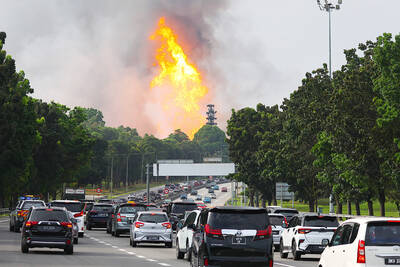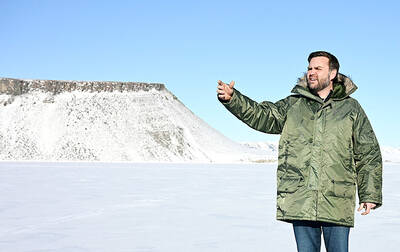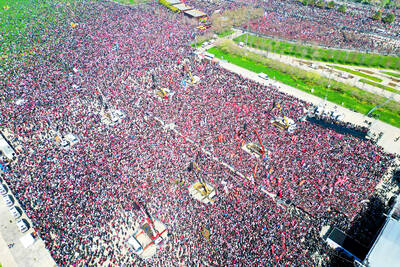Hundreds of Japanese anti-nuclear activists protested yesterday as French Prime Minister Francois Fillon toured a new atomic facility here built in partnership between the two nations.
The plant in the northern region of Aomori is expected to begin operations next month, but critics charge that it poses an environmental safety risk and could also be vulnerable to one of the region’s frequent earthquake.
Undaunted, Fillon said that Paris and Tokyo, which are major nuclear supporters, should seek to vaunt the benefits of sharing that technology with developing nations too.
“It is important France and Japan are the spokesnations of the reasonable use of nuclear on a global scale,” he told reporters.
Refusing emerging economies access to civil nuclear rights would be “a political mistake,” he said.
“Step by step, by respecting all the security rules, we would like to bring developing nations toward mastery of these technologies,” he said. “It is a very important political trend.”
Fillon said he hoped Paris and Tokyo would be able to press for a “common action in favor of civilian nuclear energy” at a July summit of the G8 group of the world’s leading industrialized nations, which Japan is hosting.
Some 700 protesters rallied in Aomori, the main town in the prefecture of the same name and near Rokkasho, where the facility was built by Japan Nuclear Fuel and France’s nuclear giant Areva.
The nuclear reprocessing plant is “the biggest and most dangerous obstacle to directing Japan towards a safe and clean energy future,” the environmental group Greenpeace said in a statement.
“Areva is aggressively promoting nuclear power expansion despite the risks, poor value for money and ineffectiveness in combating problems such as climate change,” it said.
Protesters also worried about a possibly active quake faultline.
A major quake could trigger “an enormous amount of radiation leakage [that] will affect not only local residents here, but also the global environment,” said Koji Asaishi, a lawyer involved in four lawsuits focused on the possible existence of an active faultline.
A map published by Japan’s Active Fault Research Center does not specify a faultline in Rokkasho, but shows at least seven in Aomori Prefecture.
Last year, a quake last year measuring 6.8 on the Richter scale killed 14 people and damaged the world’s largest nuclear power plant northwest of Tokyo, which leaked tiny amounts of radiation.
That plant currently remains shut for inspections.
Japan lacks virtually any natural energy sources of its own and relies on nuclear power for about one-third of its needs despite public opposition over safety concerns in the only nation to have been attacked with atomic bombs.
Trade minister Akira Amari said the Rokkasho plant was essential.
“As the head of Japan’s energy policy and a politician who believes in the future of nuclear energy, I feel deeply grateful to the people in Japan and France who have worked for the plant,” he said, adding that it met extremely high safety standards.
In recent months, France has signed deals in civilian nuclear cooperation with Algeria, Libya and the United Arab Emirates, which are first steps necessary before studying the possibility of building nuclear power stations.
“If we are unable to find — thanks to science — a means to bring to these inhabitants the energy they need to develop, then we will be forced to prepare for very gloomy days,” Fillon said.

A fire caused by a burst gas pipe yesterday spread to several homes and sent a fireball soaring into the sky outside Malaysia’s largest city, injuring more than 100 people. The towering inferno near a gas station in Putra Heights outside Kuala Lumpur was visible for kilometers and lasted for several hours. It happened during a public holiday as Muslims, who are the majority in Malaysia, celebrate the second day of Eid al-Fitr. National oil company Petronas said the fire started at one of its gas pipelines at 8:10am and the affected pipeline was later isolated. Disaster management officials said shutting the

US Vice President J.D. Vance on Friday accused Denmark of not having done enough to protect Greenland, when he visited the strategically placed and resource-rich Danish territory coveted by US President Donald Trump. Vance made his comment during a trip to the Pituffik Space Base in northwestern Greenland, a visit viewed by Copenhagen and Nuuk as a provocation. “Our message to Denmark is very simple: You have not done a good job by the people of Greenland,” Vance told a news conference. “You have under-invested in the people of Greenland, and you have under-invested in the security architecture of this

Japan unveiled a plan on Thursday to evacuate around 120,000 residents and tourists from its southern islets near Taiwan within six days in the event of an “emergency”. The plan was put together as “the security situation surrounding our nation grows severe” and with an “emergency” in mind, the government’s crisis management office said. Exactly what that emergency might be was left unspecified in the plan but it envisages the evacuation of around 120,000 people in five Japanese islets close to Taiwan. China claims Taiwan as part of its territory and has stepped up military pressure in recent years, including

UNREST: The authorities in Turkey arrested 13 Turkish journalists in five days, deported a BBC correspondent and on Thursday arrested a reporter from Sweden Waving flags and chanting slogans, many hundreds of thousands of anti-government demonstrators on Saturday rallied in Istanbul, Turkey, in defence of democracy after the arrest of Istanbul Mayor Ekrem Imamoglu which sparked Turkey’s worst street unrest in more than a decade. Under a cloudless blue sky, vast crowds gathered in Maltepe on the Asian side of Turkey’s biggest city on the eve of the Eid al-Fitr celebration which started yesterday, marking the end of Ramadan. Ozgur Ozel, chairman of the main opposition Republican People’s Party (CHP), which organized the rally, said there were 2.2 million people in the crowd, but